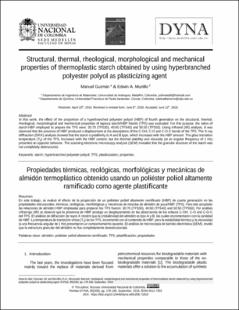Structural, thermal, rheological, morphological and mechanical properties of thermoplastic starch obtained by using hyperbranched polyester polyol as plasticizing agent
Artículo de revista
2018-07-01
Revista DYNA
Bogota ,Colombia
In this work, the effect of the proportion of a hyperbranched polyester polyol (HBP) of fourth generation on the structural, thermal, rheological, morphological and mechanical properties of tapioca starch/HBP blends (TPS) was evaluated. For this purpose, the ratios of starch:HBP employed to prepare the TPS were: 30:70 (TPS30), 40:60 (TPS40) and 50:50 (TPS50). Using infrared (IR) analysis, it was observed that the presence of HBP produced a displacement at the absorptions of the C-OH, C-O and C-O-C bonds of the TPS. The X-ray diffraction (DRX) analysis showed that the starch crystallinity is A and B type, which increased with the HBP amount. The glass transition temperature (Tg) of the TPS, increased with the HBP content, but the thermal stability and viscosity (at an angular frequency of 1 Hz) presented an opposite behavior. The scanning electronic microscopy analysis (SEM) revealed that the granular structure of the starch was not completely destructured. En este trabajo, se evaluó el efecto de la proporción de un poliéster poliol altamente ramificado (HBP) de cuarta generación en las propiedades estructurales, térmicas, reológicas, morfológicas y mecánicas de mezclas de almidón de yuca/HBP (TPS). Para este propósito las relaciones de almidón:HBP empleadas para preparar los TPS fueron: 30:70 (TPS30), 40:60 (TPS40) and 50:50 (TPS50). Por análisis infrarrojo (IR) se observó que la presencia de HBP produjo un desplazamiento en las absorciones de los enlaces C-OH, C-O and C-O-C del TPS. El análisis de difracción de rayos X mostró que la cristalinidad del almidón es tipo A y B, las cuales incrementaron con la cantidad de HBP. La temperatura de transición vítrea (Tg) de los TPS, incrementó con el contenido de HBP, pero la estabilidad térmica y la viscosidad (a una frecuencia angular de 1 Hz) presentaron un comportamiento opuesto. El análisis de microscopia de barrido electrónica (SEM), reveló que la estructura granular del almidón no fue completamente desestructurada.
Descripción:
Structural, thermal, rheological, morphological and mechanical properties of thermoplastic starch obtained by using hyperbranched polyester polyol as plasticizing agent.pdf
Título: Structural, thermal, rheological, morphological and mechanical properties of thermoplastic starch obtained by using hyperbranched polyester polyol as plasticizing agent.pdf
Tamaño: 738.5Kb
 PDF
PDF
 LEER EN FLIP
LEER EN FLIP
Título: Structural, thermal, rheological, morphological and mechanical properties of thermoplastic starch obtained by using hyperbranched polyester polyol as plasticizing agent.pdf
Tamaño: 738.5Kb
 PDF
PDF
 LEER EN FLIP
LEER EN FLIP
















